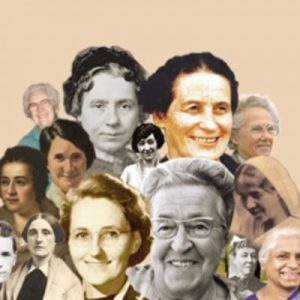SARAH ADAMS AND THE RISE OF WOMEN HYMN-WRITERS
Nineteenth century hymnody was characterized by an extraordinary number of women hymn-writers. It is significant that this development came, as we have noted in a previous chapter, with the great spiritual revivals which aroused evangelical Europe and America from 1800 to 1875. It was also coincident with the general movement resulting in the enlargement of women’s influence and activity in all spheres of human endeavor. In the realm of hymnody women have become the chief exponents of church song.
Dr. Breed has pointed out that the large increase of women hymnists, as well as the preponderance of hymn translations, is indicative of a period of decadence in sacred song. While this is probably true of the latter half of the nineteenth century, which saw the rise of the so-called “Gospel song,” we must cheerfully recognize the fact that such women as Charlotte Elliott, Sarah Adams, Cecil Alexander and Frances Havergal in England and Mary Lathbury, Anna Warner, Catherine Esling, Harriet Beecher Stowe, Phoebe Gary, Elizabeth Prentiss and Fanny Crosby in America have contributed some of the most precious gems to the treasure-store of Christian hymns. Indeed, the hymnody of the Church would have been immeasurably poorer had these consecrated women failed to make use of their heaven-born talent.
And, although we must deplore the apparent fact that “original utterance in sacred song is departing from the 298Church,” we must be forever grateful to such gifted women as Catherine Winkworth and the Borthwick sisters, who, through their excellent translations, gave to the English-speaking world some of the choicest pearls of German hymnody.
Charlotte Elliott was the forerunner of the long line of women hymnists. Then came Sarah Flower Adams, the writer of “Nearer, my God, to Thee,” one of the greatest sacred lyrics ever given to the world, and probably the finest ever written by a woman.
Sarah Flower was born at Harlow, England, February 22, 1805, the daughter of Benjamin Flower, editor of the Cambridge “Intelligencer.” The mother died when Sarah was only five years old. A sister, Eliza, was a gifted musician, while Sarah early showed talent along literary lines. In later years Eliza wrote music for the hymns of her sister.
Sarah was fond of the stage. She believed that it could be made to teach great moral truths as well as the pulpit. Her dreams of becoming an actress, however, failed to materialize because of poor health. In 1834 she became the wife of John Bridges Adams, a civil engineer, after which she made her home in London. Her health was seriously impaired through caring for her sister, who died a consumptive in 1846, and she survived her less than two years.
Her great hymn was written in 1840. It was published the following year in a volume of hymns and anthems edited by her pastor, Rev. William Johnson Fox. This man was a Unitarian, and for this reason Mrs. Adams has also been classified with that sect. It is said, however, that she became a Baptist near the close of her life. Other hymns written by her indicate that she had arrived at a living faith in Christ. Perhaps the many trials she suffered proved in the 299end to be the means of bringing her to the Saviour. And thus was fulfilled in her own life the beautiful lines:
|
E’en though it be a cross That raiseth me. |
“Nearer, my God, to Thee” has probably aroused more discussion than any other hymn. Because it is based entirely on the story of Jacob at Bethel and omits reference to Christ, it has been called more Unitarian than Christian. Many efforts have been made, but without much success, to write a substitute hymn with a definite Christian note. In 1864 Bishop How of London wrote a hymn, the first stanza of which reads:
|
Nearer, O God, to Thee! Hear Thou our prayer; E’en though a heavy cross Fainting we bear. Still all our prayer shall be Nearer, O God, to Thee, Nearer to Thee! |
Prof. Henry Eyster Jacobs of Philadelphia, in 1887, also wrote a version:
|
Nearer, my God, to Thee, Nearer to Thee! Through Word and Sacrament Thou com’st to me. Thy grace is ever near, Thy Spirit ever here Drawing to Thee. |
The hymn was a favorite with William McKinley, the martyred president. When he was dying, his attending physician heard him murmur, “‘Nearer, my God, to Thee, E’en though it be a cross,’ has been my constant prayer.”
From the book ‘Story of Our Hymns‘

Leave a Reply